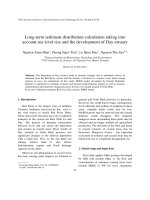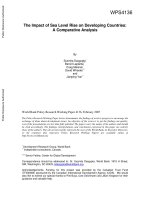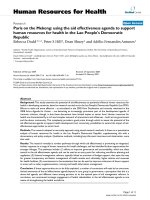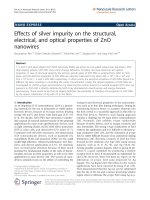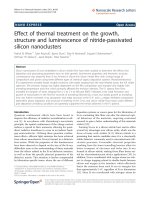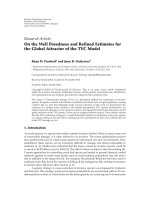Identification of Sea Level Rise impacts on the Mekong Delta and Orientation of adaptation activities ppsx
Bạn đang xem bản rút gọn của tài liệu. Xem và tải ngay bản đầy đủ của tài liệu tại đây (245.04 KB, 6 trang )
1
Identification of Sea Level Rise impacts on the Mekong Delta and
Orientation of adaptation activities
Trinh Cong Van, Ph.D,
The Hydraulic Engineering Consultant Corp. 2
169, Tran Quoc Thao Street, District 3, HCMC, Vietnam
The Mekong Delta comprises 13 provinces of Long An, Tien Giang, Vinh Long, Ben Tre, ,ong Thap,
Tra Vinh, Can Tho, Hau Giang, Bac Lieu, Soc Trang, An Giang, Kien Giang, and Ca Mau, with the
land area of 39,712 km
2
making up 12.1% of the whole country area. The population is about 17.4
million people in 2006, occupying 21% of the whole country population. The Mekong Delta is located
in an important area special on socio-economic development in Viet Nam. Comparing to the whole
nation, agricultural output of the Delta accounts for 50%, exported food productions are about 90%,
fruit trees and aquaculture products are about 70%. The Mekong Delta is a low land area under
strong effect of the East Sea (South China sea) and West Sea (Thailand gulf). Apart from some hilly
regions in An Giang and Kien Giang, most of the natural area of the Delta has a very low elevation
(below +2.0m). The high water level of the East Sea tide (rising up to +2.14m) is an agent
transmitting the tidal effect to the extremely far Mekong Delta area along main rivers. Due to the low
natural relief under high tide of the East and West Seas, the Mekong Delta would suffer great harm
under the effect of sea water rising in the future. According to the 2007 IPCC interim
recommendation, in case of sea level rises-up to 1m, an area of 15,000 to 20,000 km
2
in the Mekong
Delta
would be flooded, resulting in millions of people having to move their housings and agricultural
production being seriously reduced. If the effect of the sea level rising on the Delta is not properly
cared and studied for preparing a strategic action plan, the damages would be very big to the Vietnam
economy and food security in the area. Within this article, it would only cover some initial ideas only
for an identification of impacts of the sea level rising on the Mekong Delt and recommend orientation
of adaptation activities
1. Sea Level Rise
Higher temperatures are expected to further raise sea level by expanding ocean water, melting
mountain glaciers, and causing portions of Greenland and the Antarctic ice sheets to melt. Over the
period 1961 to 2003, the global ocean
temperature had risen by 0.10
0
C. For the period
1993 to 2003, the rate of sea level rise is
estimated from observations with satellite as
3.1±0.7 mm yr
-1
, significantly higher than the
average rate during the past 40 years. It is
estimated by the IPCC that the global average
sea level would rise between 0.18 and 0.59
meters. The sea level is rising along the coast of
Vietnam. In the past 50 years, the sea level has
risen by 20cm at Hondau station in Hai Phong
province. Based on the data between 1979 and
2006 of Vung Tau gauge station, Truong Van
Hieu (Sub-institute of Meteorology and Hydrology in HCMC) has reported that the HHWL of sea
level at this station has risen by 13 cm.
While the current model projections indicate substantial variability in sea level rise in the future at
regional and locales, the IPCC has concluded that the impacts are « virtually certain to be
overwhelmingly negative » (IPCC, 2007). The Water and Agriculture sectors are likely to be most
sensitive to climate change and sea level rise – induced impacts in Vietnam.
Past and Projected global average sea level
(IPCC, SRES A1B, 2007)
2
2. Identification of Sea Level Rise impacts on the Mekong Delta
Impacts of the sea level rise on coastal areas
The coastal area is known as strips of land being located nearest to the sea where they are totally
influenced by saline water all the year. Fresh water supply to these areas is difficult and costly,
especially for agricultural production. Moreover, these areas are under direct impacts of the sea such
as wave, wind, storm, etc. Widths of these strips of land
are naturally defined or limited by the outer boundary of
the water resources projects for controlling saline water.
Economic activities in these areas are mainly dominated
by aquaculture, fishing, salt production, afforestation, and
services related to tourism, river – sea transport, etc. The
forecasted climate change would result in increase in the
number of storms from seas, whirlwinds, and strength of
these disasters is likely to abnormally increase. Weather
in recent years in our country and the Mekong Delta as
well has had manifestations conformable to the warnings
by the scientists.
Together with the sea level rising, effects of coast erosion in the area would increase suddenly
.
Development of the reservoirs generating power in the upstream Mekong River by the nations such as
China, Myanmar, Laos, etc. has been changing flow regime in the dry season and flood season, and
seriously reducing sedimentation to the Mekong Delta. This situation is an agent that not only makes
the coast erosion more serious but also degrades the coastal ecosystem. The coastal cajuput and
mangrove forest remaining in narrow areas as now would be likely to disappear due to being deeply
flooded; subgrade would be scoured or its nutritive content would not be sufficient any more. In recent
years, the “seaward” development has more and more increased; therefore, the potential damage due
to natural disasters in the coastal areas to human beings and properties is bigger and bigger,
particularly for our country where there are still not plannings for sustainable development considering
the climate change and sea level rising process. The erosion in some areas such as Go Cong, Ganh
Hao would be suddenly increased. The results from several studies assumed that when sea level rises
by 30cm, the coast line is likely to be eroded at about 45m.
The coastal engineering structures including ports and sea dykes would be under the great increasing
effects of sea waves when water depth in front of the structures increases and seashore disappears due
to erosion, or protective forest belt disappears. Many sea dyke structures of which safety is not assured
any more that is not only due to the dyke crest elevation not being assured but also because forces on
the dyke body and seepage flow into dyke, etc. exceed the initial design capacity. The existing sea
dyke in Tien Giang and some sections of the sea dykes in Ca Mau and Bac Lieu are typical samples
for this situation. Other infrastructures such as houses, roads, bridges and sluices, etc. would be
flooded in the future if they are not built based on the designs considering the sea level rising factor.
The sea level rising would have negative impacts on environment of the coastal areas as well.
Impacts of the sea level rise on salt water intrusion
Under the tidal effect, saline water intrudes into fields and is inclined to enter further due to decrease
of fresh water resource from the Mekong upstream for various reasons. Saline water in Bassac River
intrudes beyond Dai Ngai location of 8 to 10 km; the salinity of 1 g/l in CoChien river also enters
beyond Vung Liem canal; in Ham Luong river by February and April of many years at 5 to 10 km
upstream of Ben Tre canal, water also had not been used for drinking; in the Mekong river the salinity
of 4 g/l intrudes beyond My Tho location of about 10km. Agriculture production in the past decade in
the Mekong Delta has obtained great achievements of which one important part was thanks to
hydraulic structural measures to control saline water intrusion, fresh water protection, and flood
reduction. The fresh water is taken at the upstream side of the project areas of coastal provinces. When
BIN TRÌNH Hmax VÀ Htb NM TRM V
NG TÀU
Thi k 1979 - 2006 , M$c "0" H'i ()
y = 0.4855x - 548.21
y
= 0.3546x - 444.52
2
00
250
3
00
350
4
00
450
5
00
1
979 1982 1985 1988 1991 1994 1997 2000 2003 2006
N1m
H(cm)
HmaxnamVT HtbnamVT
Linear (HmaxnamVT) Linear (HtbnamVT)
Sea level at Vung Tau station between 1979
and 2006 (according to Truong Van Hieu)
3
the sea water rises, saline water would be conveyed further in main rivers, resulting in the fact that the
existing irrigation schemes are likely to be
broken because the “fresh water extraction”
gates of the projects would catch saline.
The South Mang Thit water control project with
the command area of about 225,682 ha in Vinh
Long and Tra Vinh provinces was constructed in
1990s. The project has brought great socio-
economic effectiveness by increasing agricultural
production and improving rural environment, etc.
The project includes (i)saline prevention
structures such as sea dyke, Ham Luong river
dyke, Bassac river dyke, sluices for saline
prevention like Lang The, Can Chong, etc.
(ii)irrigation and drainage canal system including
fresh water intakes upstream. When sea water
rises, the salinity of over 4g/l would cross the
Mang Thit River that would result in
malfuctioning of the whole project. The
conveyance of fresh water resource from a
further location (despite of higher cost) would be
very difficult due to an insufficient hydraulic gradient.
Another example, Quan Lo – Phung Hiep irrigation project was constructed during the early 1990s for
serving the benefited areas of about 263,743 ha of Soc Trang, Bac Lieu, and Ca Mau provinces. The
fresh water taken from Bassac River is presently not able to reach Ca Mau because the conveyance
distance is too long, and demarcation of saline water and fresh water is still a complicated question for
the area. In the future when sea water rises, the possibility of fresh water supply from Bassac river
would become more difficult while saline water would be delivered further into the Ca Mau peninsula
center.
Inshort, several water control projects in Tien Giang and Ben Tre would be also suffered by the risk of
losing the fresh water supply.
The East Sea (China sea) tide is of semidiurnal regime with two approximatively high water levels and
two differently low water levels; high water level is between +1.0 and +2.14m whereas low water
level fluctuates between -2.68 and -1.99m. The M-shaped tide has one LWL in high elevation which
makes a difficulty to drain water from fields. The West Sea (Thailand gulf) tide has small tidal range
(about 1m), with the high water level between +0.7 and +1.1m whereas the low water level is about
between -0.4 and -0.5m. When sea water rises, both tidal regimes would have negative impacts on the
Mekong Delta. The forecast (Chen, 1991 and Zang & Du, 2000) assumes that the rising of average
high level is more than the rising speed of average water level. The actual measured data at Vung Tau
station also shows this, meaning that the risk to the Mekong Delta is bigger. The sea water rise would
also result in the fact that scopes of the existing river and sea dykes may be insufficient to make sure
the functions of protecting the highest tidal level. Some sections of the dykes would have to be even
relocated to further land due to the seashore erosion. Sluices for saline water prevention – flooding
drainage would operate with tidal level rising higher than the initial design; therefore, the drainage
possibility would be considerably reduced compared to the plan. For sluices along the West Sea under
the effect of tide with small amplitude, when the sea water rises the drainage possibility would
considerably decrease, resulting in the functions of the project not being asssured. In general, most of
the existing fresh water control projects in the Mekong Delta would cope with the risk of being
seriously broken under the impacts of the sea level rising in the future.
The upstream area of the Delta is an area not being contaminated with saline water and located in the
further land near the Vietnamese – Cambodian border. The area is some 45% of the entire Delta
presently. The sea water rising would widen the area under saline intrusion and narrow the fresh water
Irrigation schemes in Mekong delta with
existing boundary condition of saline
(according to SIWP, HCMC)
4
area. Based on a preliminary calculation, if mitigation measures are not taken, saline water is likely to
be pushed up to An Giang in Bassac River. Further saline water intrusion would not only narrow the
existing fresh water area but also affect fresh water intakes of the above-mentioned projects. Flow in
the Mekong River in the dry season would extremely decrease because of the effects of the projects for
irrigation and diversion out of the Mekong Basin of the upstream nations and of adverse change in rain
regime within the area as well. In such situations, the sea water rising would result in serious impacts
on the largest rice production areas of Vietnam, impeding socio-economic development of the entire
delta and affecting the food security in the area and over the world.
Impacts of the Sea level rise on flooding in the Mekong Delta area
The Mekong delta flood planning has been approved by the Government for building projects
(structural and non-structural measures) step by step to reduce damage caused by floods. In fact, only
elementary part of the Long Xuyen quadrangle flood control project (or named the West Sea flood
discharge project) has just been implemented including the boundary overflowing flood control line
and structures for saline intrusion control and flood drainage along the West Sea in An Giang and Kien
Giang provinces. As soon as this phase was completed by 2000, the Long Xuyen quadrangle has been
rapidly developed not only in agricultural production but also in great improvement in aquatic
environment, land reclamation, upgrading of rural infrastructures, etc. Flood control in Plain of Reeds
(Dong Thap Muoi) is still under study and testing by construction of some projects for flood water
diversion.
Flood control in the Mekong delta was planned
for deep and shallow flooded areas. Early flood
control is applied for deep flooded area by
embankment system for safety harvesting
Summer-Autumn crops before discharging the
main flood into fields. Full flood control is
applied for shallow flooded areas by embankment
systems to allow cultivation of triple crops or fruit
trees.
The sea level rising obstructing directly flood
discharge to sea would make water levels in main
rivers rise higher than it would be causing
flooding in a wider area and longer flooding duration. The early flood would be higher in the future
and duration of the ending flood drainage for the entire delta would be longer affecting directly the
cultivation of winter-Spring crop cultivation in the Delta. It is likely that height of the present dyke for
residential areas would be threatened when water level rising higher than planned. Water level in
rivers and canals rising high would also result in drainage of local rain-water, particularly in urban and
residential areas.
According to the IPCC prediction, by the end of the 21
st
century for scenario A1B, the mean sea level
may rise by some 50cm compared to the 1990 water level while there are still extremer scenarios and
forecasts. With the low ground elevation that is quickly harmed even when water level increases
several centimeters, the Mekong Delta would be under extreme impacts of the sea level rising
phenomenon. Many areas where rain water can be naturally drained presently would be likely to be
flooded if they are not dewatered into main rivers. The areas along the Gulf of Thailand would suffer
flooding in a long period since tidal range is small and low water level is naturally about -0.50m only
presently; therefore, when the sea water rises by 50cm more, much land area would not be able to
drain itself.
In general, the sea level rising would make a strong impact and reduce the capacity of flood drainage
into the sea, resulting in serious flooding that have negative impacts on the agricultural production
systems in the Mekong delta in the future. Big cities like Hochiminh, Can Tho, Long Xuyen, etc.
would be seriously flooded due to rain, flood and tide or combination of these.
Tidal flooding in Hochominh city
5
3. Orientation of Adaptation Activities
Climate change and sea level rising have been confirmed to be the greatest hazards to human beings
must face in the 21
st
century. The increasing tendency of negative consequences of climate change
including the sea level rising is not reversible and there were forecasts more serious than what was
forecasted by IPCC, 2007. Vietnam would be one of the countries under strongest effects of the sea
level rising phenomenon, in which the Mekong delta would suffer great harm if there are no properly
and timely measures to cope with.
The tackling measures include two groups of main actions which are “mitigation” and “adaptation”.
The “mitigation” actions, globally, have been recommended to reduce the use of fossil origin fuels
(such as petroleum, coal), avoid methane emission, and reforestation to absorb carbon dioxide, etc.
Many options are possible for the “adaptive” actions, for instance, when sea water rising high,
residents in the coastal areas can move to further land, sea dykes can be improved to a sufficient height
for copping with the rising sea level. Similarly, when crop cultivation area can not be maintained due
to sea water intrusion shifting crop cultivation into aquaculture is an option.
3.1 Adaptation activities for development of coastal areas
To reduce socio-economic damage at a maximum level and to mitigate risks to human beings and
properties, the coastal areas are required to be considered right now. It requires to prepare planning for
cautious development considering the climate change and rising sea water factors. In which several
scenarios would be considered. Review and assessment of the existing structures are required to
prepare for upgrading and/or replacing in an appropriate way. It is also required to plan a construction
of community “Storm and flood-proofing houses” in the coastal areas. Afforestation for protecting
coastal strips must be defined that it is not only for safety of each locality but the assignment for
community interests and national benefit, from which a rational sharing policy on economy among
population communities would be given.
3.2 Adaptation activities for agricultural development
First of all, it is required to carry out rigorous and systematic surveys and studies to specifically assess
impacts of the sea level rising process on each agricultural production system under water control,
from which tackling solutions are to be proposed. Though the sea water rising in the next decades is
being warned that there would be mutative increases, this is a phenomenon progressing in years. We
can absolutely assume a rate of sea level rise with scenarios on the upstream flow and apply
mathematical models (SAL, VRSAP, MIKE…) to forecast a progress (increasing) of the areas under
saline intrusion, based on which risks of the existing irrigation schemes under water control are to be
pointed out by time. Normally, the water control projects are not to extract fresh water from one
location only. The salinity in main rivers changes by month; saline intrusion is further in the dry
season (between February and April). Even in one month, at the times when flood tide occurs with
northeast wind, saline intrusion is pushed further than the times when tide falling.
Sluices along main rivers do the functions of extracting fresh water to the project areas when water at
these tributary outlets is not yet contaminated with saline water and would have their gates closed for
saline prevention in months when saline water intrudes. Accordingly, when sea water rises, sluices
located nearer the sea would not be able to extract fresh water first, and the following sluices would be
gradually reduced in terms of the time to extract fresh water and total amount of the fresh water which
can be extracted to supply agricultural production. The mathematical model enables calculation to
forecast a possibility degradation of fresh water supply of the irrigation schemes, based on which a
tackling solution is to be proposed: Suitably changing crops, raising animals (marine products) or
increasing fresh water amount from the upstream by engineering methods. We can forecast the
progress of unsafety by time for the South Mang Thit water resources project for saline water
prevention and fresh water protection; however, when saline water crosses Mang Thit River, the
6
possibility of fresh water supply for over 200 thousands hectares of agricultural land would be
mutatively reduced. At that time, the people are required to be ready for the “adaptation” in cultivation
or the new saline control structures would have been constructed in time and commissioned. It is
required to appraise the “nonconforming” of the existing schemes, each component or item of works,
each kind of engineering structure (for instance, sluice gates, hydraulic structures) by time and
scenarios on the sea level rising. Based on the assessment of capacity degradation of the structure
systems, we can propose tackling activities including solutions to mitigating damage of the existing
schemes, or establishing new control systems. In the future, when sea water rises high and flows in
main rivers decrease due to the water use upstream, it is likely to establish new systems by
constructing structures on the main rivers of the Mekong delta to control water level, protecting the
areas inside the delta from being flooded and intruded with saline water excessively, reducing loss of
fresh water to the sea in the periods of low flow…To be able to apply such structures in the future, we
are required to study and answer the question on the necessity to have them constructed. In which time
will the structures be needed? Impacts (unexpected) of the structures on the environment and
sustainable development…
Planning for change in crops
….for being adaptive to the new conditions in the fresh water areas
would be narrowed in the future, and the drought situation in the dry season, flooding in the wet
season are likely to be more serious and longer than before. Adjusting and upgrading of the flood
control embankment and dyke systems in conformity with the water level increase in flood season at
the localities will be required.
3.3 Adaptation activities for development of infrastructures and environment
The sea level rising would not only cause tide level higher than present but also obstruct flood
discharge to the sea resulting in severer flooding due to tide for the coastal areas and serious
inundation for areas in the Mekong delta center. It is required to upgrade the existing infrastructures
such as roads, urban drainage systems to meet the requirements when water levels in rivers and canals
increase in the rainy, flood, or flood tide seasons. Planning for development of residential areas,
especially new big cities to be constructed require a consideration of the climate change and sea level
rising consequence. The poor drainage and flooding in a wide area lasting long would cause
difficulties in the treatment of living and industrial environments; consequently, it is required not to
resolutely locate industrial zones with great exhaust in the center of the Mekong delta. The
mathematical model enables a forecast on water level in the entire Mekong delta with scenarios on
flood, rain, etc., and the sea level rising after each decade. If, in agricultural production, the adaptation
can be applied step by step in a respective way to the sea level rising, the construction of
infrastructures requires a regulation applying design criteria for the 20 to 50 or 100 year forecasts.
4. Conclusion
The sea level rising, consequence of the global climate change, inclining to quickly increase in the
next decades would extremely affect hydrological factors and flow regimes in river and canal systems
of the Mekong Delta, increasing saline intrusion and serious flooding, making an adverse effect on the
socio-economic development and environment.
Copping with the sea level rising process firstly requires awareness from the highest levels of
State management to the people of challenges in different fields of economy, especially in agriculture
and aquaculture. The impacts are required to be assessed and “quantified” objectively, thoroughly, and
specifically as the base for planning strategies for long-term adaptation and suitable response to the
short-term construction and development.

